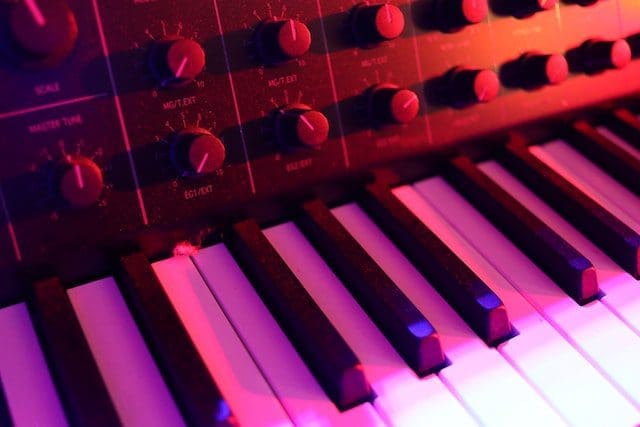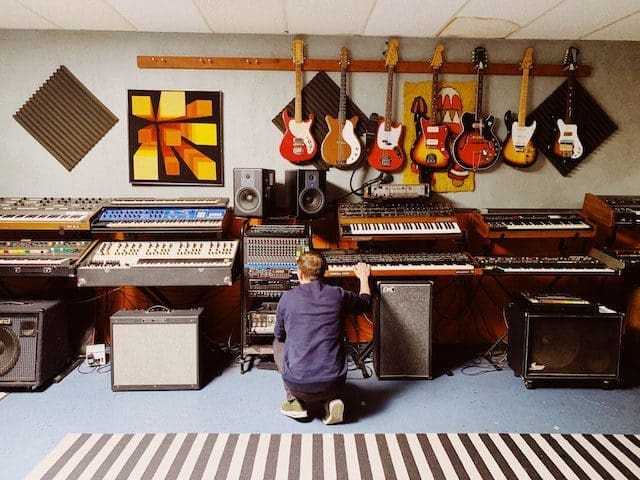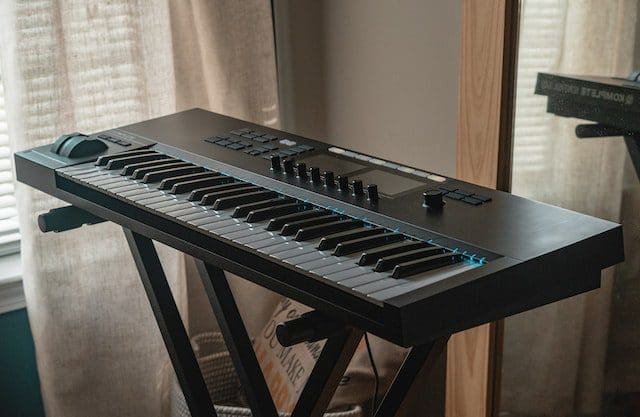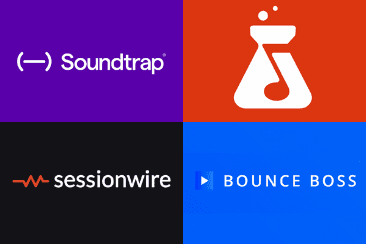Are you looking to find out more about the Yamaha DX1 features and what makes it such a special synthesizer? Do you want to know the Yamaha DX1 price and how that has changed since it was originally made? We can’t get enough of one of the top synths in the music industry so we will tell you all about it. Let’s go!
What Is The Yamaha DX1?
The Yamaha DX1 is the top-level member of Yamaha’s prolific DX series of FM synthesizers. It is extremely rare and one of the most elusive FM synthesizers that Yamaha have ever made. It would be very hard to buy one today. It is like having two FM Dx7s in one box, but in terms of this particular synth, it is in a wooden box and there is a wood trim. In short, you have 2 different 6 operator FM synthesizers in one machine.
This synth allows for either double the polyphony, split of two voices, or dual (layered) instrument voices. In addition, it contains twice the amount of voice memory as the DX7. It has an independent voice bank for each of two synth channels (engines). Each of 64 performance combinations can be assigned a single voice number, or a combination of two voice numbers – one from channel A and one from channel B.
Only 140 were made and there may be less in existence today, so if you manage to see one, then really make the most of it!
There are fully-weighted keys and in terms of the FM synth engine, there is a large display so you can see what is going as you play. It tells you how your algorithms are being routed or your operators.
There is an envelope generator, keyboard scaling, sensitivity for your velocity for your keys.

What Are The Main Features Of The Yamaha DX1?
As we have touched upon above, there are plenty of features that would make any musician very happy. This is not your average synth. Let’s go into more detail.
Case
- The case is a beautiful handmade Brazilian rosewood case. The paneling is perhaps the most ornate part of the product.
Keyboard
- There is a 73-key weighted wooden keyboard with polyphonic aftertouch.
Algorithms
- On the left side of the front panel, a printed algorithm chart provides an overview of the 32 selectable algorithms and their associated operator structuring.
Displays
Compared to both the DX5 and of course the DX7, accessibility and programmability are greatly enhanced by the sheer amount of displays available:
Performance section
- a comprehensive backlit LCD display (40 × 2 characters) which displays selected programs in Single, Dual or Split mode, as well as LFO setting and other voice-specific parameters
Algorithm panel
- thirteen single-character 7-segment numeric displays for indicating (by means of 1, 2, 4, 6 displays in 4 consecutive rows, from top to bottom) the selected algorithm, by providing positions and relationships of all active operators, as each one of these displays is linked to neighboring ones via individual stripe-style LEDs
- one single-character 7-segment numeric display (top) showing amount of feedback
- one double-character 7-segment numeric display (bottom) showing algorithm number (as referenced by the chart)
Oscillator panel
- two individual LEDs for indicating either (top) frequency ratio or (bottom) fixed frequency in Hz mode
- one individual LED for indicating positive or negative detune
- one single-character 7-segment numeric display (top) for detune amount
- one four-character 7-segment numeric display (bottom) for value (ratio or exact frequency) of the selected frequency mode
Envelope panel
- two individual LEDs for indicating either (left) center pitch or (right) amplitude level mode
- eight double-character 7-segment numeric displays for showing each individual envelope parameter, from top to bottom: R1, R2, R3, R4 (=rates) and L1, L2, L3, L4 (=levels)
- four 16-segment bar-style LEDs that graphically display either rates (in center pitch mode) or levels (in amplitude mode)
Keyboard scaling panel
- eight individual LEDs indicating selected curve response
- three double-character 7-segment numeric displays showing (left to right) left depth, break point, right depth values
- one single-character 7-segment numeric display for showing rate scaling
Sensitivity panel
- two single-character 7-segment displays showing (top) key velocity and (bottom) amplitude modulation
- one double-character 7-segment display showing output level
- one 16-segment bar-style LED that graphically displays the output level
Buttons
- solid push-buttons as opposed to the membrane buttons on the DX7, many of them containing individual LEDs for indicating statuses
For all of those features, you would definitely need to use the Yamaha DX1 manual to really get to know your way round the system. You can now understand why there is a pretty hefty price tag put on these synthesizers. Remember that it was made in a time when digital synths were only just starting to make some headway over analogues synths.
Yamaha DX1 Price Tag
So back in the early 80s when the first Yamaha DX1 was manufactured, it would have cost you around $14,000 in 1984 and in terms of what that would cost now, we are looking at around $33,500. So it means that back in the day, it would have only been achievable to buy one if you were a wealthy superstar or super rich. I’m sure nothing will come up if you type ‘Yamaha DX1 Ebay’ into your search engine, or they will certainly be sold out, but you can try it.
However, if you are looking for a Yamaha DX1, Reverb may be able to help you, as I have seen a Yamaha DX1 Programmable Algorithm Synthesizer advertised – it may not still be on sale – for £6,745.98, which is less than I thought it would be. Have you heard of a Yamaha DX1 for sale at this price?
Also it is worth mentioning that other sellers on a similar site may charge more, as there is another DX1 available for £134,938.12, so make sure you review the product before you make a purchase.

Hypersynth Hcard-705
If you are looking for a Yamaha DX1 cartridge, then the hypersynth Hcard-705 is exactly what you need. This is a multibank cartridge pair for expanding the external memory of Yamaha DX5 and DX1. Pretty clever right?
The DX5/1 voice memory is limited to 32 presets for each parts A and B, which could be upgraded to 64 presets by adding an external Yamaha “Data RAM” cartridge. “Data RAM” is discontinued, rare, and expensive. Its third-party versions rely on a battery for data retention. “Hcard-705” can be used as a drop-in replacement for Yamaha “DATA RAM” cartridge. It stores up to 400 banks per cartridge without the worry of battery life and data loss. Hcard-705 is compatible with DX5/1 voice and performance format.
The “Hcard-705″ pair is loaded with 52 voicebanks per card, of which bank 2-3 includes Yamaha DX1 DX5 ROMs (original voice).
FM Synthesizers In DAWs?
In relation to synthesizers, if you want to find something similar to a Yamaha DX1 VST, then there are plugin softwares available for your DAWs today. For example, Ableton Live or Logic certainly do use FM synthesizers already built in.
There is even FM Suite which is a collection of 5 new and updated instruments that deliver the history of FM synthesis straight into your DAW.
You will find a collection of authentic vintage hardware FM sounds, and there are 8 FM synthesizers, from common to the ultra-rare, like the dual 6-operator Yamaha DX1.
Software has progressed in recent years so soft synths have become an item most musicians will invest in, but it must be said that to use a real synth up close, there would of course be a marked difference in experience. It’s good to hear that there are now more affordable analog synths for you to purchase.
We go into more detail in other articles about the difference between a vst and an analog synth, so do check this out.
Notable Players Of The DX1 Yamaha
Plenty have all played this unique and now very rare piece of equipment. Here is a list of just some of them.
- Depeche Mode, Pet Shop Boys, Herbie Hancock, Elton John and Paul McCartney, Junkie XL, Roland Orzabal, Chris Lowe, Steve Porcaro, David Paich, Jonathan Wilson, Paul Epworth, Ian Stanley Guy E. Fletcher, Minoru Mukaiya.
It did become too large and expensive, so it was followed by DX5 – more affordable and compact. Most DX1 units were made as 100V. And nobody would be able to reject the amount of power it has – just look at all those buttons!

Final Thoughts
Now, if you are looking to purchase one of the Yamaha DX1 synths, then you should be prepared to have some large savings ready to go. But with all of those incredible features and the history beyond one of them, then who wouldn’t want one? It truly was and still is a beautiful piece of kit.
Are You A Musician Or Artist?
Develop your brand with artist development and get your music heard in TV and film with sync licensing and collaborate globally with other musicians, songwriters, and producers. Finally, amplify your music to those that need to hear it with music marketing, promotion and Spotify. Try all of this out for yourself by joining Мusic Gateway.










